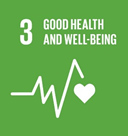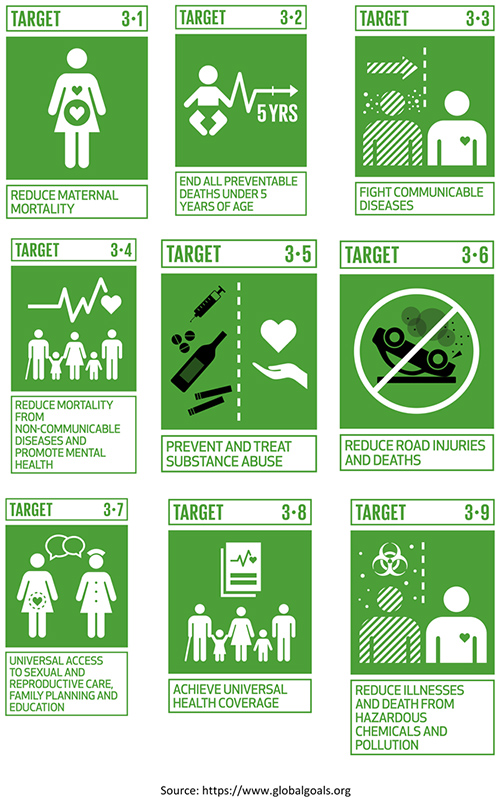Sustainable Development Goals (SDGs) – How can Engineers contribute to improve health and well-being of our society?
By : Eng. Saja A.A. MajeedWhen we hear the word ‘health’, the first thing comes to anyone’s mind is the medical profession, - “Doctors”. While the medical profession is the corner stone to develop the health sector, health sector also requires a multi-disciplinary approach. Like any other key sectors in development, the health sector has many cross-cutting themes even within the medical profession and inter-sectoral disciplines, such as public heath engineering, health infrastructure and technology development.
 Engineering solutions can improve the quality of the health care systems through new technologies to reach people who live in remote locations where there is lack of health care facilities. For example, Grameen Communications in Bangladesh and Kyushu University in Japan have developed the Portable Health Clinic (PHC), a compact telehealth system that seeks to reach remote communities with quality healthcare (RAE 2016). How do Engineers contribute to good health and well-being? and how can we do better in the future in the context of achieving Sustainable Development Goal (SDG) 3 – ‘’, which is to ensure healthy lives and promote wellbeing for all at all ages. In the SDG 3, child health, maternal health, and control of communicable and non-communicable diseases are given priorities. Although Sri Lanka’s health system has shown a good progress on child and maternal health care and the mitigation of communicable diseases such as Malaria and Tuberculosis, the changes in disease patterns and emerging concerns on the increase of non-communicable diseases need to be addressed (VNR 2018).
Engineering solutions can improve the quality of the health care systems through new technologies to reach people who live in remote locations where there is lack of health care facilities. For example, Grameen Communications in Bangladesh and Kyushu University in Japan have developed the Portable Health Clinic (PHC), a compact telehealth system that seeks to reach remote communities with quality healthcare (RAE 2016). How do Engineers contribute to good health and well-being? and how can we do better in the future in the context of achieving Sustainable Development Goal (SDG) 3 – ‘’, which is to ensure healthy lives and promote wellbeing for all at all ages. In the SDG 3, child health, maternal health, and control of communicable and non-communicable diseases are given priorities. Although Sri Lanka’s health system has shown a good progress on child and maternal health care and the mitigation of communicable diseases such as Malaria and Tuberculosis, the changes in disease patterns and emerging concerns on the increase of non-communicable diseases need to be addressed (VNR 2018).
According to United Nation statistics, at least half the world’s population are still with-out access to essential health services (UN 2017). More efforts and investments are required to curb the growing burden of non-communicable diseases and environmental risk factors such as air and water pollution that lead to poor health, particularly affecting the most vulnerable and poor segments of the community. The global key figures related to healthy life and well-being of people include (UN 2019):
- There is a drop of under 5 years death 9.8 million in 2000 to 5.4 million in 2017.
- 80% drop measles death between 200 and 2017 due to vaccinations
- 3.5 million more malaria cases in African countries in 2017 compared to 2016.
- tuberculosis incidence rate declined by 21% between 2000 and 2017; however 10 million people developed tuberculosis in 2017
- The incidence of HIV among adults 15‒49 years old in sub-Saharan Africa declined by 37% between 2010 and 2017
The achievement of SDG 3 is interlinked to every other SDG in some way. For example, SDG 6 – clean water and sanitation can largely reduce the mortality and morbidity from the environmental hazards, the poor performance in nutrition (SDG 2 – no hunger) has negative impact on children’s physical and mental health and well-being, and education and awareness on disease prevention is a necessity to ensure a sustainably healthy population (SDG 4 – quality education).

SDG 3 sets out nine key targets and four additional targets for resource mobilisation and policy to be achieved by 2030. The nine key targets are:
3.1. By 2030, reduce the global maternal mortality ratio to less than 70 per 100,000 live births.
3.2. By 2030, end preventable deaths of new-borns and children under 5 years of age, with all countries aiming to reduce neonatal mortality to at least as low as 12 per 1,000 live births and under-5 mortality to at least as low as 25 per 1,000 live births.
3.3. By 2030, end the epidemics of AIDS, tuberculosis, malaria and neglected tropical diseases and combat hepatitis, water-borne diseases and other communicable diseases.
3.4. By 2030, reduce by one third premature mortality from non-communicable diseases through prevention and treatment and promote mental health and well-being.
3.5. Strengthen the prevention and treatment of substance abuse, including narcotic drug abuse and harmful use of alcohol.
3.6. By 2020, halve the number of global deaths and injuries from road traffic accidents.
3.7. By 2030, ensure universal access to sexual and reproductive health-care services, including for family planning, information and education, and the integration of reproductive health into national strategies and programmes.
3.8. Achieve universal health coverage, including financial risk protection, access to quality essential health-care services and access to safe, effective, quality and affordable essential medicines and vaccines for all.
3.9. By 2030, substantially reduce the number of deaths and illnesses from hazardous chemicals and air, water and soil pollution and contamination.
The resource mobilisation target is to increase health financing, recruitment, training and retention of the health workforce. The policy related targets are to implement World Health Organization Framework Convention on Tobacco Control, support the research and development of vaccines and medicines for the communicable and non-communicable diseases, and strengthen the early warning for managing health risks at national and regional levels.
The achievement of healthy lives and promotion of well-being is measured by many indicators. The key indicator is mortality ratio in the following cases:
- Mortality ratio (maternal, neonatal, under 5 years)
- Mortality ratio of non-communicable diseases and due to suicide and traffic accidents
- Mortality ratio due to air and water pollution
Further to the above mortality ratio indicators, other key indicators for measuring SDG 3 targets include:
- Number of epidemic incidences (HIV infections, Tuberculosis, Malaria, Hepatitis B)
- Coverage of essential health care services
- Household level health care expenditure
- Health worker density and population
- Health emergency preparedness capacity
Detail indicator descriptions are available at https://unstats.un.org/sdgs website.
The current status of achieving SDG 3 in Sri Lanka was reported in the recent review by the Government of Sri Lanka. The maternal, under five, and neonatal mortality rates (34 per 100,000 live births, 10 per 1,000 live births, 5.8 per 1,000 live births respectively) in Sri Lanka are well below the SDG targets (Targets 3.1 and 3.2). Three key areas require immediate attention in the health sector under SDG 3 targets with the help of other cross-cutting sectors (VNR 2018): a. the communicable disease such as dengue needs support from environmental sector, b. non-communicable diseases such as cardiovascular diseases and chronic kidney diseases of unknown aetiology (CKDu) require attention from sectors such as environment and water, c. deaths and injuries from road accidents needs support from the transportation and urban planning sectors. For road accidents, in 2018 alone, 3,164 were killed due to road accidents including 1,211 riders, 930 pedestrians, and 423 passengers (Dailymirror 2019). In 2019, 78,260 suspected dengue cases were reported to the Epidemiology Unit, Ministry of Health from all over the island. The trend shows, approximately 46 % of dengue cases were reported from the Western province and dengue cases were mostly reported in many large cities and urban areas in Sri Lanka. The incidences of CKDu in Sri Lanka has been reported to be doubling every four to five years and currently more than 150,000 people are affected and 3% of those affected are died annually (Wimalawansa, 2015, kafle 2019)
In Sri Lanka, the entire population is covered by public health system (target 3.8). However, the estate sector still lacks behind with sufficient health care systems compared to other urban and rural areas in the country. The effective management of health care facilities and the improvement of health care standards to avoid overcrowding has been identified as an important challenge in Sri Lanka. This necessitates an important potential contribution of Engineers to the health sector is to provide infrastructure and technological support to make the health system accessible to all population, particularly to the marginalised population. The contribution of Engineers can also involve in introducing innovative technologies for improving public health at the community level and advancing medical facilities available at different health care systems from primary to tertiary health care facilities. There has been wider scope for integrating many information and communication technology platforms in the health sector.
The achievements of Young Engineers around the World in advancing the UN Sustainable Development Goals produced by World Federation of Engineering Organizations (WFEO) highlight two case studies that advanced SDG 3, both of them were reported to be initiated by two young Engineers. The first project example is installing solar panels to provide electricity to public hospitals which do not have access to electricity. The second project example for the contribution of SDG 3 achievement is to build eco-sanitation facilities including rainwater harvesting system for handwashing and cleaning in hospitals (for more about these projects, refer https://www.wfeo.org). Although the two examples above highlight an important contribution to the health sector for the marginalised communities in a resource-limited setting, much more advancements can be done to the health sector through innovative technologies in other contexts such as in urban areas, which are increasingly threatened by public health risks and environmental hazards.
In the next issue of digital SLEN, we will continue with the snapshot of SDG 4: Quality education. All SDGs are well connected, and thus require a holistic view to address real development challenges. Until then, let us reflect on SDG 3 – Good Health and Well-being and their implication to Engineering profession. Your comments on how we as Engineers can contribute to achieve SDGs can be posted in the following IESL Facebook page https://www.facebook.com/IESLSriLanka/ .
References:
- https://unstats.un.org/sdgs/indicators/Global%20Indicator%20Framework%20after%202019%20refinement_Eng.pdf
- https://www.wfeo.org/wp-content/uploads/stc-young_engineers/WYEC-BROCHURE_FINAL_VERSION.pdf
- Achieving the United Nations Sustainable Development Goals, Engineering a better world, Royal Academy of Engineering, 2016. https://www.raeng.org.uk/publications/other/engineering-a-better-world-brochure
- S.J. Wimalawansa, Agrochemicals and chronic kidney disease of multi-factorial origin: environmentally induced occupational exposure disease, Int. J. Nephrol. Kidney Fail. ISSN (2015), pp. 2380-54981, 10.16966/2380-5498.111.
- Kafle, K., Balasubramanya, S., & Horbulyk, T. (2019). Prevalence of chronic kidney disease in Sri Lanka: A profile of affected districts reliant on groundwater. Science of the Total Environment, 694, 133767.
- Sri Lanka Voluntary National Review on the Status of Implementing Sustainable Development Goals, Ministry of Sustainable Development, Wildlife and Regional Development, Published by the Ministry of Sustainable Development, Wildlife and Regional Development in June, 2018.
- Ensure healthy lives and promote well-being for all at all ages, United Nations, 2019, Infographic UN SDG 3 – Health and well-being.
https://www.un.org/sustainabledevelopment/wp-content/uploads/2019/07/E_Infographic_03.pdf
 Eng. Saja A.A. Majeed
Eng. Saja A.A. Majeed
Lecturer
Faculty of Engineering, South Eastern University of Sri Lanka.
